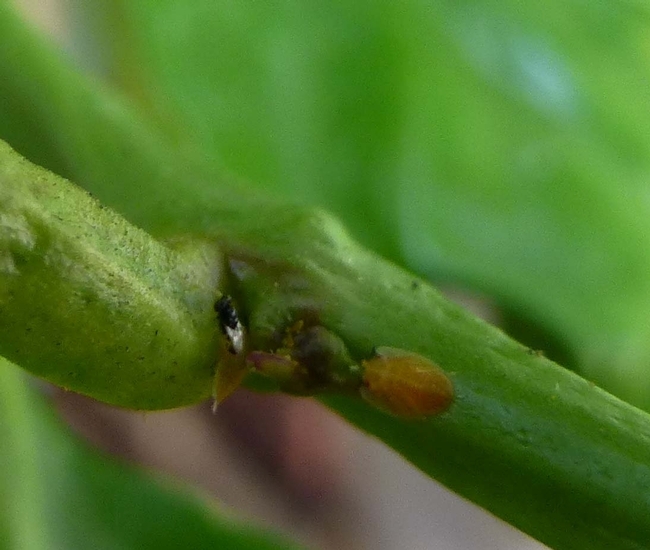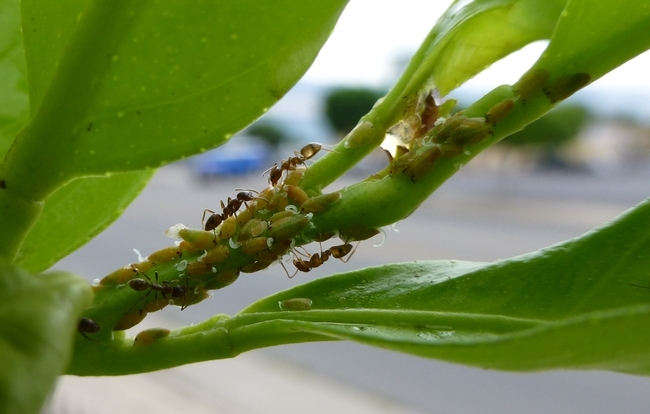Posts Tagged: citrus greening
Deadly Citrus Greening Disease: A Better Lure for Asian Citrus Psyllids
If you like or grow citrus, you ought to be worried about the worldwide threat of the deadly citrus greening disease (Huanglongbing or HLB) caused by...
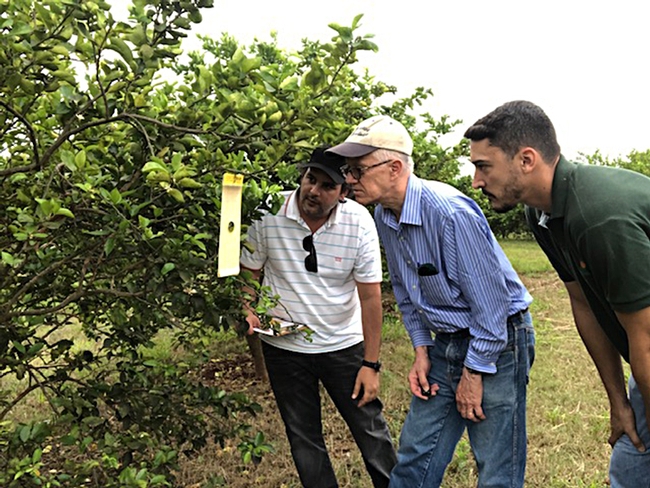
UC Davis chemical ecologist Walter Leal (center) examines a lure in Mogi Mirin, São Paulo on Brazil’s Independence Day (Sept. 7) with Haroldo Volpe (far right) and Renato de Freitas, both of Fundecitrus.
Targeting the Asian Citrus Psyllid
A major citrus pest may experience a “Bah, Humbug!” kind of year. If all goes as planned, UC Davis chemical ecologist Walter Leal's...
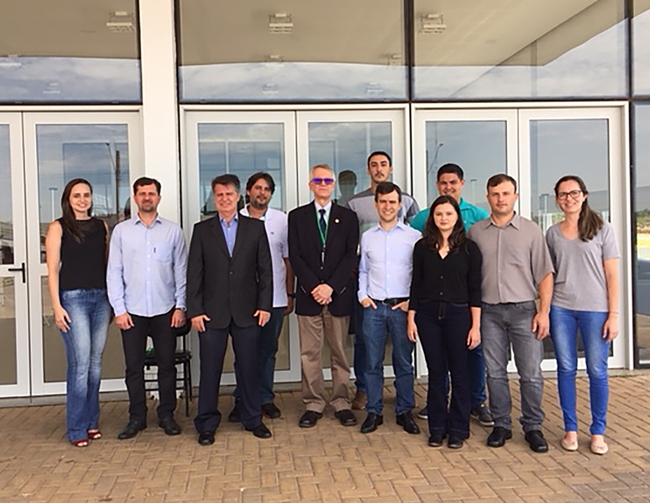
The Asian Citrus Psyllid Team: Scientists in the front row (from left) are Tatiana Mulinari, Rodrigo Magnani, Antonio Juliano Ayres, Walter Leal, Marcelo Miranda, Victoria Esperanca, Odimar Zanardi, and Rejane Luvizotto. The three scientists in back are Haroldo X. L. Volpe (white shirt) Renato de Freitas and Rômulo Carvalho.
Invasive meltdown
Ants can be a huge nuisance in and outside our homes, particularly if you have food lying around. But now, it turns out, they’re unwelcome, too, on citrus trees.
A year ago, UC Riverside entomologists released Tamarixia, a parasitoid wasp and natural enemy of the Asian citrus psyllid (ACP) imported from Pakistan, into a biocontrol grove in Riverside, Calif. Tamarixia can serve as an excellent biocontrol agent against ACP, a citrus pest first detected in 2008 in Southern California that is capable of spreading citrus greening disease, or Huanglongbing.
Tamarixia’s success starts with a female laying an egg on the underbelly of an ACP nymph. When the egg hatches, the parasitoid larva will scrape away the nymph’s belly, carving out a hole to push through to enter the nymph’s body. Feeding on the contents, the larva eventually excavates the entire nymph, leaving only a shell or husk of the nymph behind.
Female Tamarixia can kill psyllids also by “host-feeding.” They use their ovipositors as daggers to stab psyllid nymphs numerous times until the nymphs start to bleed. As bodily fluids ooze out of the nymph, Tamarixia sucks up this rich protein needed for developing more eggs.
An excellent way then to control ACP populations! Yes, but only until the ants come marching in. Argentine ants are threatening to disrupt the biocontrol of ACP by battling it out with Tamarixia on citrus branches. While not quite a Vader-Skywalker lightsaber duel on a precarious walkway, an “invasive meltdown” begins when the ants gang up to protect the nymphs.
“ACP nymphs produce a white, sugary waste product called honeydew, a good carbohydrate source for the ants,” explains Mark Hoddle, the director of the Center for Invasive Species Research at UC Riverside, whose research team has released Tamarixia into several Southern California citrus groves. “The ants, therefore, will protect the nymphs from Tamarixia. We have seen ants chase female Tamarixia off the psyllids, and even catch and eat them!”
“If you kill off the ants, Tamarixia can play the role of the biocontrol agent it was cast to do on citrus trees,” Hoddle says. “We’re seeing that the ants are impacting Tamarixia in two ways: they are preventing Tamarixia’s establishment in some areas; and, where Tamarixia is already established, the ants are not allowing these parasitoids to reach their full biocontrol potential.”
USDA to provide $11 million for citrus greening research
The USDA will provide $11 million for scientific research to battle citrus greening disease, according to a USDA news release issued this morning. Citrus greening disease is spread by the Asian citrus psyllid, which made its way to California in 2008. When a tree acquires the disease from the pest, nutrient flow is obstructed, the fruit stays green, grows lopsided and tastes bitter.
USDA will invest $2 million this year for research at the U.S. Horticultural Research Laboratory in Ft. Pierce, Fla. The remaining $9 million will be offered in a three-year competitive grants program by the agency's National Institute of Food and Agriculture.
The news release said USDA will also establish a Citrus Disease Research and Development Advisory Committee with representatives from the grower and scientific communities. The advisory committee, which reports to U.S. agriculture secretary Tom Vilsack, will provide leadership to citrus disease scientists.
Citrus greening is one of the most devastating diseases affecting any commercial agricultural crop, according to the National Academy of Sciences. More than 250,000 jobs representing key sectors of the U.S. economy are at risk, including harvesting, packaging, processing, transportation, marketing, retail sales, and nursery production.
Citrus greening threatens to destroy over 1 million commercial citrus acres that have an annual production value of approximately $3 billion across the nation. Yearly losses could reach $10 billion if citrus greening is left unchecked.
Asian citrus psyllid was first detected in California in San Diego and Imperial counties. The pest is believed to have been introduced from northern Mexico. Adult psyllids have also been trapped in Orange, Los Angeles and Ventura counties. The University of California, California Department of Food and Agriculture, USDA and the citrus industry are working closely to quarantine the affected areas and try to eradicate the pest.
The state of Florida first detected the Asian citrus psyllid in 1998 and citrus greening disease seven years later. The pest and disease have been detected in all 30 of Florida's citrus producing counties and in Louisiana, Georgia and South Carolina. The states of Texas, Mississippi and Alabama, like California, have detected the pest but not the disease.
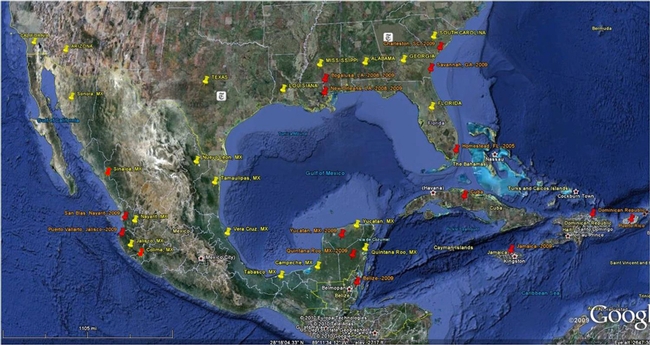
Red pins on the Texas Department of Agriculture map show where citrus greening disease has been found. Yellow pins show where Asian citrus psyllid has been found.
Genetic modification may be only way to save citrus industry
Genetic modification is the best long-term hope for the citrus industry when faced with huanglongbing disease, according to a Reuters special report, however, opposition to so-called "Frankenfood" is expected.
Reuters centered its story in Florida, where huanglongbing, or citrus greening disease, was first identified in 2005. The devastating citrus disease is spread by Asian citrus psyllid (ACP), which made it's way into the Sunshine State in 1998.
Asian citrus psyllid was found in California in 2008; to date huanglongbing has not been found. The psyllid attacks leaves and stems of citrus, injecting a toxin when it feeds that causes leaves to twist and die. But the real threat is huanglongbing (HLB), "yellow dragon disease."
HLB can kill a citrus tree within 3 to 5 years, and there is no known cure. Once a tree is infected with HLB, the only way to prevent its spread is to remove and destroy the infected tree.
In the short-term growers are increasingly relying on pesticides to keep ACP at bay, the article said. The practice carries the risk of insects developing pesticide resistance, groundwater contamination and disruption of an integrated pest management program that depends on beneficial insects.
The biotech industry and geneticists in particular are making an all-out push to develop an effective weapon against greening, such as citrus trees genetically modified to be resistant to HLB. USDA scientist Calvin Arnold told the reporters he believes the general public is likely to accept GMO orange juice.
"I think especially here in the U.S., they're understanding transgenics a lot better. Just like people go to Taco Bell, they know they're eating crops that have been produced transgenically," Arnold was quoted.
For more on Asian citrus psyllid in California, see the UC Kearney Agricultural Center Citrus Entomology website.
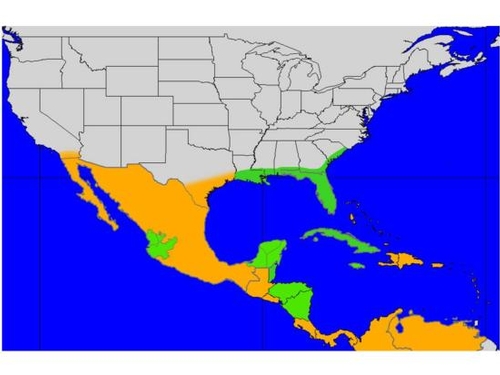
North American distribution of ACP is in orange; areas with ACP and HLB are in green.


